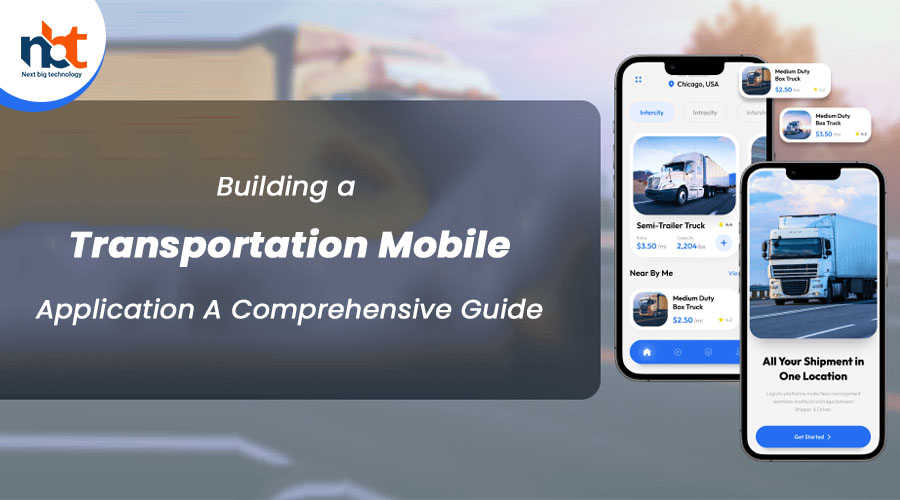Introduction:
Transportation mobile applications have transformed the way people commute and navigate through cities. These apps provide users with convenient access to various transportation services, such as ride-hailing, public transit information, bike-sharing, and more. If you’re considering building a transportation mobile application, this comprehensive guide will walk you through the step-by-step process. From defining your app’s objectives to designing an intuitive user interface, integrating essential features, and ensuring a seamless transportation experience, we’ll cover everything you need to know to create a successful transportation mobile application. Let’s get started!
- Define Your App’s Objectives and Target Audience:
- Identify the focus of your transportation app (ride-hailing, public transit, bike-sharing, etc.)
- Determine your target audience (commuters, tourists, students, etc.)
- Analyze the competition and identify unique selling points for your app
- Choose the Right Platform and Technology:
- Select the mobile app platform (iOS, Android, or both)
- Determine the programming languages and frameworks (Swift, Kotlin, React Native, Flutter, etc.)
- Consider the backend infrastructure and database options
- Design an Intuitive User Interface:
- Create wireframes and prototypes to visualize the app’s layout and user flow
- Design a visually appealing and user-friendly interface
- Focus on simplicity, clear navigation, and intuitive controls
- Implement User Registration and Authentication:
- Enable users to create accounts and log in securely
- Implement password encryption and data protection measures
- Allow users to save their preferences and payment information for seamless bookings
- Integrate Transportation Services and APIs:
- Partner with ride-hailing services, public transit agencies, bike-sharing networks, etc.
- Integrate with their APIs to access real-time data on vehicle availability, routes, and schedules
- Provide information on fares, estimated arrival times, and service disruptions
- Provide Seamless Booking and Reservation:
- Enable users to book rides, reserve seats on public transit, or rent bikes
- Implement multiple payment options (credit/debit cards, digital wallets, etc.)
- Offer a streamlined booking process with clear steps and confirmation
- Implement Real-time Tracking and Navigation:
- Integrate mapping and GPS services for real-time vehicle tracking
- Provide navigation instructions for users to reach their destinations efficiently
- Offer estimated arrival times and distance calculations
- Incorporate Fare Calculation and Payment Integration:
- Implement fare calculation algorithms based on distance, time, or surge pricing
- Integrate secure payment gateways for seamless transactions
- Provide electronic receipts and trip history for reference
- Enable User Feedback and Ratings:
- Allow users to rate drivers, vehicles, or transit services
- Incorporate a feedback system to gather user reviews and suggestions
- Regularly review user feedback to improve the app’s functionality and user experience
- Integrate Multi-modal Transportation Options:
- Provide information on various transportation modes and their interconnectivity
- Offer route planning options that combine different modes for optimal travel
- Enable users to switch between modes seamlessly within the app
- Implement Real-time Notifications and Alerts:
- Send notifications for vehicle arrival, departure times, or service disruptions
- Provide alerts for traffic conditions, delays, or route changes
- Allow users to customize notification preferences based on their preferences
- Ensure Data Security and Privacy:
- Implement secure data storage and transmission protocols
- Comply with data protection regulations (GDPR, CCPA, etc.)
- Communicate your privacy policy clearly and obtain user consent
- Conduct Thorough Testing and Quality Assurance:
- Test the app for functionality, usability, and performance
- Conduct rigorous testing on different devices, screen sizes, and operating systems
- Identify and fix any bugs or issues before launching the app
- Launch and Promote Your App:
- Prepare for app store submission and approval process
- Develop a marketing strategy to attract users and create brand awareness
- Leverage social media, content marketing, and partnerships with transportation service providers
Conclusion:
Building a transportation mobile application requires careful planning, thoughtful design, and efficient development. By defining your app’s objectives, choosing the right platform and technology, designing an intuitive user interface, integrating essential features like booking, real-time tracking, and multi-modal transportation options, you can create a successful transportation mobile application. Remember to prioritize user experience, real-time updates, and data security. With a well-developed transportation app, you can provide users with a convenient and seamless way to navigate and commute, enhancing their overall transportation experience and contributing to more sustainable and efficient urban mobility.









